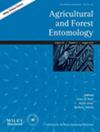The smell of infection: Disease surveillance in insects using volatile organic compounds
IF 1.8
3区 农林科学
Q2 ENTOMOLOGY
引用次数: 0
Abstract



感染的气味:利用挥发性有机化合物监测昆虫疾病
昆虫在几乎所有生态系统中都发挥着至关重要的作用,并提供广泛的生态系统服务。然而,受管理的昆虫和野生昆虫种群都面临着寄生虫和病原体的威胁,需要进行监测以减轻威胁。目前的昆虫传染病监测方法通常采用人工检查和分子检测等侵入性、耗时且偶尔具有破坏性的技术。挥发性有机化合物 (VOC) 监测为疾病检测提供了一种实时、准确和非侵入性的替代方法,并已在人类和牲畜中得到广泛应用。传感器技术的最新进展使得现场挥发性有机化合物监测设备的开发成为可能。本综述以蜜蜂为例,探讨了昆虫疾病监测的需求,并重点介绍了为此目的使用挥发性有机化合物的最新进展。我们概述了将挥发性有机化合物用于昆虫疾病监测的潜在应用、挑战和未来前景,并举例说明如何在全球范围内应用这项技术来减轻疾病对一系列昆虫系统的影响。
本文章由计算机程序翻译,如有差异,请以英文原文为准。
求助全文
约1分钟内获得全文
求助全文
来源期刊

Agricultural and Forest Entomology
农林科学-昆虫学
CiteScore
3.60
自引率
6.20%
发文量
66
审稿时长
>24 weeks
期刊介绍:
Agricultural and Forest Entomology provides a multi-disciplinary and international forum in which researchers can present their work on all aspects of agricultural and forest entomology to other researchers, policy makers and professionals.
The Journal welcomes primary research papers, reviews and short communications on entomological research relevant to the control of insect and other arthropod pests. We invite high quality original research papers on the biology, population dynamics, impact and management of pests of the full range of forest, agricultural and horticultural crops.
 求助内容:
求助内容: 应助结果提醒方式:
应助结果提醒方式:


